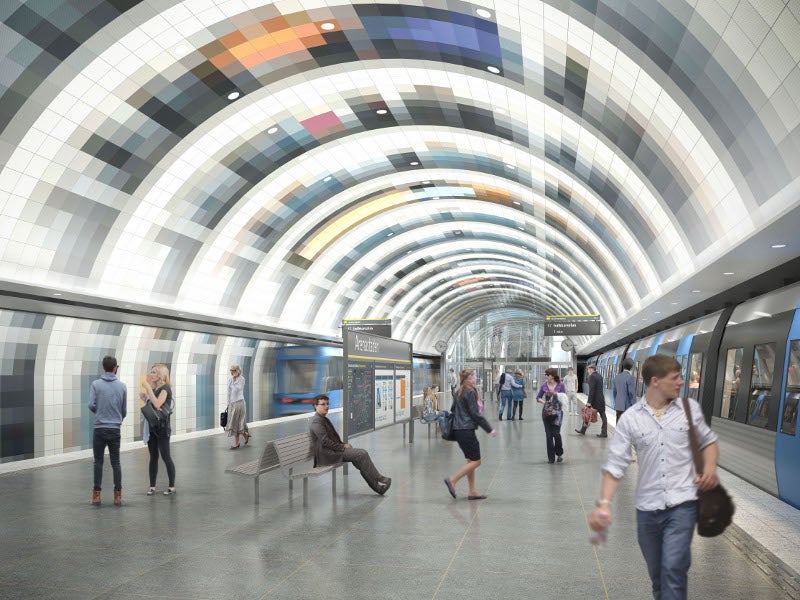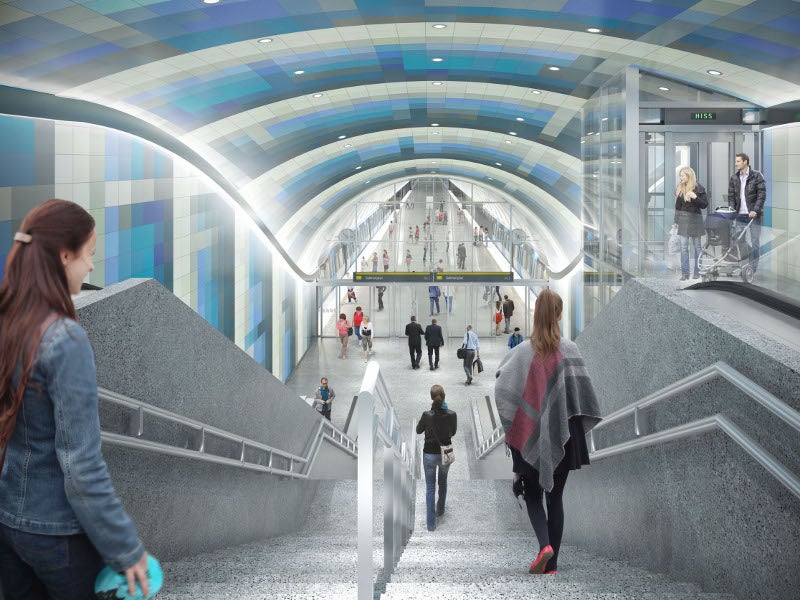Stockholm metro rail network in Sweden is being expanded with 20km of new track and 11 new stations on four sections in the region.
The agreement for the expansion of Stockholm metro’s underground network was signed by Region Stockholm, the City of Stockholm, the Municipality of Nacka, Järfälla Municipality and the City of Solna in January 2014. The municipalities will also build 78,000 residences along the new metro area.
Estimated to cost Skr29.8bn ($3.35bn), the expansion project marks the biggest investment project in the public transport of Stockholm region since the 1970s.
Initial construction work on the project commenced in November 2018 and the entire project is expected to be completed by 2030.
Stockholm metro expansion details
Stockholm metro will be expanded below ground by 11.3km from Kungsträdgården to Nacka, Södermalm and Söderort. A new tunnel will be built from Kungsträdgården to Gullmarsplan via Sofia on Södermalm.
The metro then turns southwards at Slakthusområdet station, which will replace the existing Globen and Enskede gård stations. It will be extended in a southern direction to Sockenplan station, where the blue line incorporates the existing Hagsätra line.
Other new stations to be built along the blue line include Nacka, Sofia, Hammarby Kanal, Sickla and Järla.
Gullmarsplan will serve as an interchange between the yellow, blue and red lines, the light rail and buses. It will have a new platform 70m below ground with large express lifts connecting to the existing station.
The blue line will also be extended by approximately 4km below ground from Akalla to Barkarby via Barkarbystaden. The stretch will have two new stations – Barkarbystaden and Barkarby.
The yellow line will be extended by 4.1km from Odenplan to Arenastaden in Solna. It will have three new stations at Hagastaden, Södra Hagalund and Arenastaden, which will be built 30m below ground. Hagalund station will also have the provision for accommodating a future metro station.
The yellow line will join the green line at Odenplan, where the metro will turn north to Arenastaden in Solna.
Each new station of Stockholm’s metro will feature artistic design and unique expression, aiming to improve the overall experience for passengers.
A converter station is being built in Stadshagen to supply the expanded metro with power.
Högdalen depot expansion details
The existing Högdalen depot will be expanded to serve the green and blue lines of Stockholm’s metro network. A new 2.5km-long Farsta Line-connecting track will be laid below ground to accommodate trains between the Farsta branch of the green line and the Högdal depot.
The expansion will also add 23 staging areas 20m below ground, 1,500m of staging track, as well as two workshops for train maintenance on the blue and green lines. The underground sidings shed will also be extended to create space for more trains.
The expanded depot is expected to be operational in 2025.
The new metro line between Fridhemsplan and Älvsjö
As part of the 2017 Sweden Negotiation, it was decided a standalone line between Fridhemsplan and Älvsjö would be built.
Potential routes and stations were evaluated between 2020 and 2022. The new line will stretch approximately 8km in tunnels. It will include six stations, namely Fridhemsplan, Liljeholmen, Årstaberg, Årstafältet, Östberga and Älvsjö.
Construction of the new line is expected to start in 2025, with the start of operations expected in 2034.
Contractors involved in the Stockholm metro expansion
A partnership between Ramboll, Tyréns and White was selected to provide conceptual design, rail and environmental assessments and production of the construction documents of the Akalla-Barkarby line of the Stockholm metro extension project.
Architecture and design work for the underground stations were provided by approximately 150 artists.
Encardio Rite supplied geotechnical instruments for the Stockholm metro extension project.
Amberg provided building information modelling solutions, while Siemens Mobility provided electrification solutions for the project.
CEEQUAL compared sustainability performance to international standards, highlighted best practices and innovation and provided a platform for discussion on sustainability issues.
OHLA was awarded three separate contracts for the construction of tunnels and subway stations as part of the blue line extension of the Stockholm metro, between June 2021 and October 2022.
Implenia was contracted for the construction of the new Sofia underground station and its related tunnels.
In November 2021, Swedish construction company Skanska won an Skr1.2bn ($135m) contract to construct a 1.2km-long new metro tunnel along with platform space and two ticket halls at the Nacka station.
Itinera was awarded two contracts in March 2022 for the construction of two new sections of the Stockholm metro with a total length of approximately 3.6km. The contractual scope also includes the construction of three new stations, namely Hammarby Canal, Arenastaden and Södra Hagalund.
Sweco is responsible for planning the railway layout, developing station designs and investigating the environmental impact of the new metro line between Fridhemsplan and Älvsjö, under a contract awarded in February 2022.
Strukton was awarded the Akalla-Barkarby contract in January 2022 to extend the double-track infrastructure over 4km, with work expected to be started in 2023 and completed in 2025.
KONE was contracted to supply 11 escalators and six elevators for the new Hagastaden metro station.
Stockholm’s metro expansion project benefits
The Stockholm metro expansion project aims to accommodate the growing population and address the increasing demand for public transportation. It will also meet the present and future demand for environmental, social and economic sustainability.
The metro currently handles 1.1 million passengers a day, whereas its expansion will provide service for an estimated daily ridership of 170,000.







